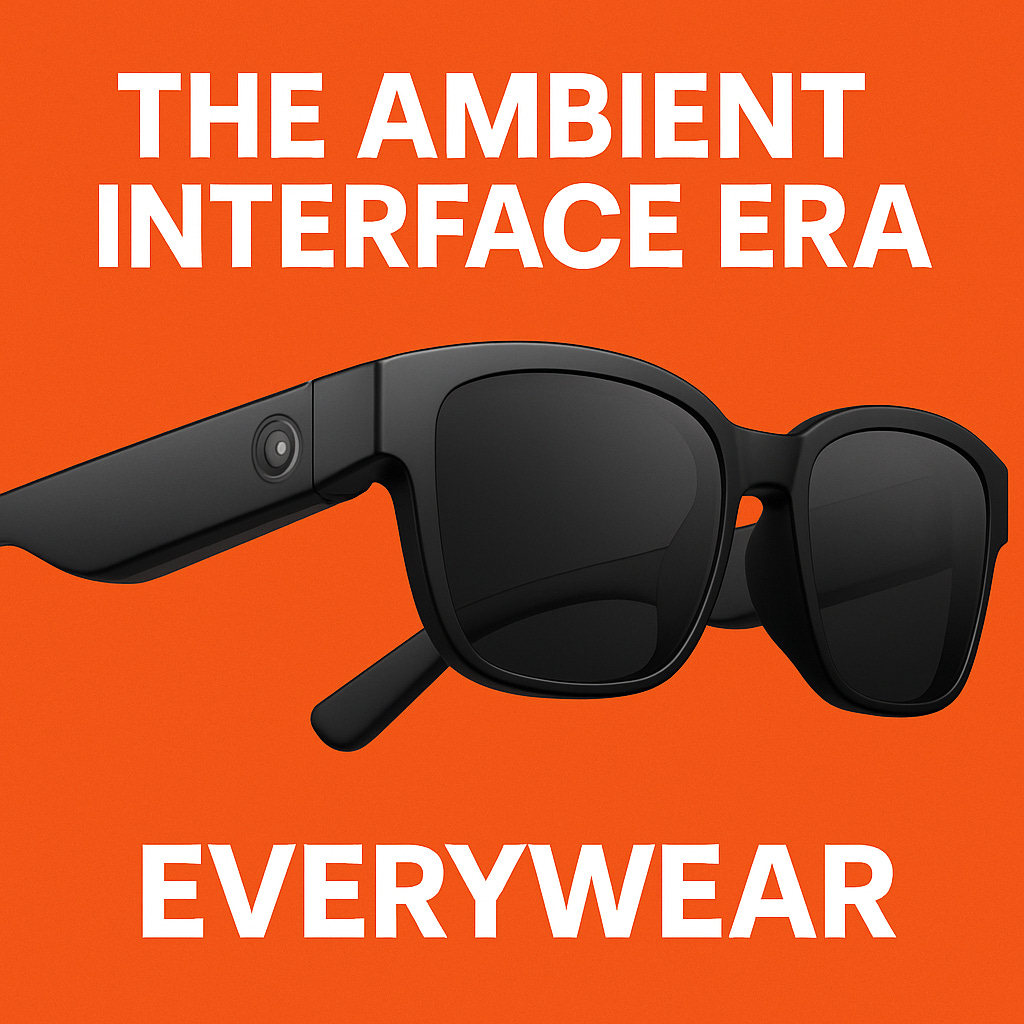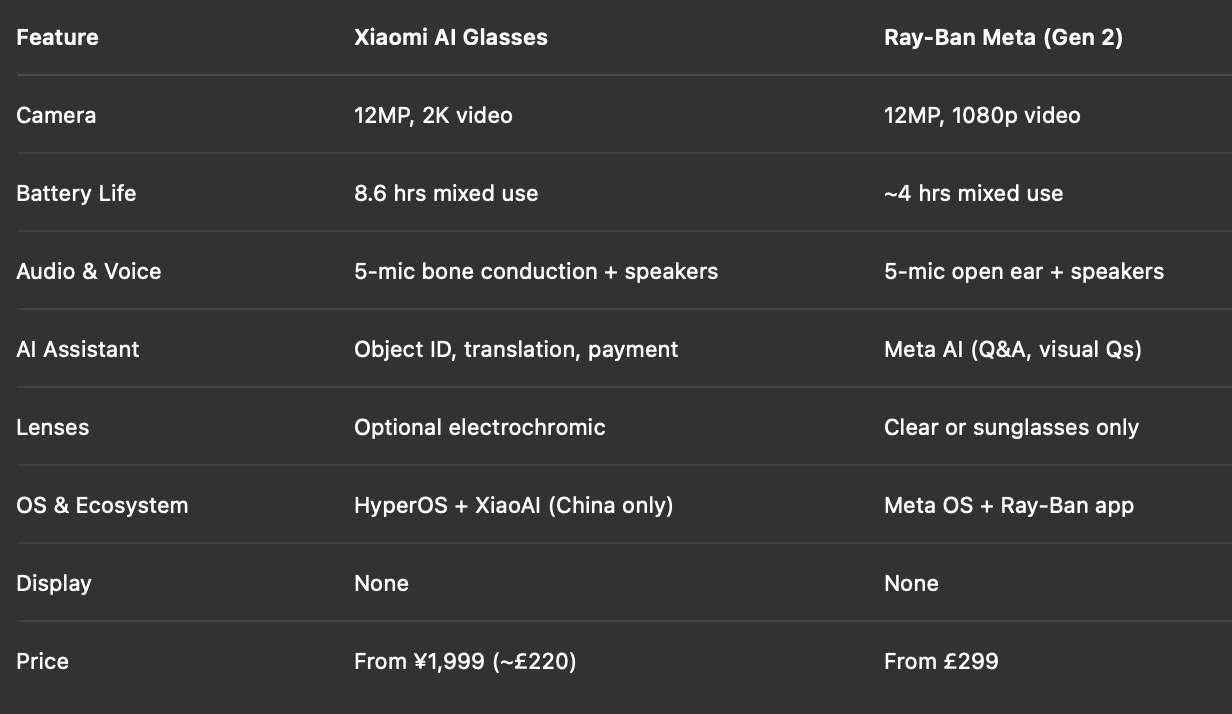The Xiaomi AI glasses that don't just look, they think
Entering the ambient interface era with smart wearables
Xiaomi’s AI Glasses aren’t trying to be a screen. They’re something else entirely: the first true ambient interface.
You’re walking through a night market in Chengdu. You point at a menu - your glasses whisper the translation. You scan a QR code and pay without pulling out your phone. You ask what food you’re holding, and it tells you the calories. No screen. No friction. Just wear and go.
This isn’t a future fantasy. It’s Xiaomi’s new AI Glasses - and they’re not trying to be another camera on your face. They’re something different. Built for action, not attention.
While Meta’s Ray-Bans have dominated Western headlines, China’s Xiaomi has quietly introduced a challenger with sharper instincts and broader ambition.
Like Meta’s, Xiaomi’s glasses don’t feature a screen. But that’s exactly what makes the comparison interesting: two products, no display - two totally different philosophies.
Meta’s Ray-Bans center around capturing moments, summoning a chatbot, and sharing through your social graph.
Xiaomi’s AI Glasses are built around recognition, translation, utility, and environmental intelligence.
They’re both screenless. But one wants to turn your face into a content creator. The other wants to turn it into an interface.
From augmented to ambient
Before Meta’s Ray-Bans reframed the category, smart glasses mostly meant augmented reality - heads-up displays, floating maps, digital overlays.
Xiaomi flips the same script. These glasses are built for ambient intelligence. No screen. No distractions. Just context-aware utility baked into your daily life.
You get a 12MP ultra-wide camera for hands-free photo and 2K video capture, a five-microphone array for accurate voice input and noise suppression, and dual open-ear speakers for calls, music, and real-time AI responses. Battery life clocks in at up to 8.6 hours - nearly double the Meta Ray-Bans, with features like object recognition, calorie estimation, live translation, and QR payments via Alipay.
They’re powered by Xiaomi’s HyperOS and HyperAI, running on the Snapdragon AR1 Gen 1 chip. And with a tap, the lenses shift from clear to tinted.
The glasses don’t just respond to what you say. They respond to what you see.
Built for China’s ecosystem of speed
In China, phones already function as identity, wallet, travel pass, and social graph. Voice commands are fluent. QR codes are everywhere.
So Xiaomi’s AI Glasses don’t feel futuristic. They feel native.
These glasses weigh just 40g, are splash-resistant (IP54), and come in clear or electrochromic lenses.
They blend utility and invisibility. Built not to show off, but to keep up.
Designed to disappear
In China, phones already function as identity, wallet, travel pass, and social graph. Voice assistants are fluent. QR codes are everywhere.
Xiaomi’s AI Glasses don’t feel futuristic. They feel native.
They weigh just 40g, are splash-resistant (IP54), and come with clear or electrochromic lenses. Tap the frame, and your lenses shift from clear to shaded in a flash - part practicality, part design flex.
These glasses look like eyewear. Not headsets.
They blend in, by design.
Meta vs Xiaomi: Two paths to the face
Both are lightweight, camera-first, AI-forward, and screenless. But their intentions couldn’t be more different.
Meta is building social smartglasses, share-first and assistant-enhanced.
Xiaomi is building utilitarian smartglasses, assistive-first and socially silent.
Why this matters
Smart glasses are evolving from “look at me” gadgets to silent, intelligent companions.
We’re moving from augmented reality to ambient reality. From digital overlays to invisible cognition.
Xiaomi’s AI Glasses show what that looks like when it’s already plugged into a local super ecosystem - one that others like Huawei, Oppo, and even ByteDance are watching closely.
Wearables are shifting from screens you tap to those you wear. Xiaomi’s AI Glasses show how far that shift is going.
This signal a few things. Ambient AI is becoming a design principle. Context-aware computing is now lightweight and stylish, not bulky and experimental. And global competition in wearables is accelerating fast, with China’s hardware makers building serious alternatives to Silicon Valley’s ecosystem lock-in.
Even if Xiaomi’s glasses stay China-exclusive for now, they represent a global direction: wearables that subtract complexity and respond to the world in real time.
A vision of utility-led tech, where the goal isn’t to grab your attention - it’s to remove the need for it.
👓 The EVERYWEAR view
Not all smart glasses are chasing the same future.
Meta wants your face to become the new camera roll.
Xiaomi wants it to be the next interface.
Welcome to the era of ambient interfaces - wearables that think, sense, and act without asking for your eyes.
The next wave of personal tech won’t ask for your attention.
It will quietly enhance your perception.
And that shift, from glass as content tool to glass as perception engine - could define the next generation of wearables.
Maybe the future of tech isn’t on your face.
Maybe it is your face. EVERYWEAR.



